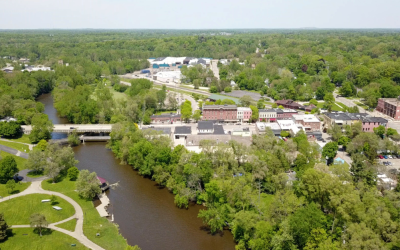By Miranda Alamilla and Lisette Partelow
The 33.2 million small businesses in the U.S. are an integral part of the economy, employing nearly half of all workers and accounting for over 40% of America’s gross domestic product.
Yet most small businesses give the federal government a grade of C or below for their small business assistance efforts. They are aware that programs exist to support them, but don’t always know how to navigate confusing federal processes.
Mayors and city governments are in a position to bridge this divide, ensuring that small businesses receive the benefits intended for them while boosting the local economy at the same time. When small businesses can access the grants, loans, tax credits, and procurement opportunities that they are eligible for, everyone wins.
Small businesses are playing a huge role in improving America’s infrastructure, including businesses that work in construction and skilled trades, architecture, engineering, job training and technical assistance, consulting and advising for project planning, energy auditing, solar panel installation, grant writing, information technology and data systems, and more. Not only will many small businesses work on infrastructure projects, many more will benefit from the improved safety of roads and bridges, expanded high-speed internet, and the pedestrian traffic created by multimodal and traffic safety projects.
Below are five ways that cities can assist their local small businesses through the Bipartisan Infrastructure Law (BIL) and the Inflation Reduction Act (IRA):
1. Connect local small businesses to national opportunities and resources
Many programs in BIL and IRA have significant set-asides for small businesses. For example, the highway programs in BIL administered by the Federal Highway Administration, Federal Transit Administration, and the National Highway Traffic Safety Administration plan to spend at least $37 billion on contracts with small and disadvantaged businesses.
To work on federal projects, small businesses first need to obtain certification through the Small Business Administration (SBA). Small businesses can get counseling and assistance through the SBA if they need additional support to make their way through the process, or work through similar city government resources, if available. Opportunities for certified business are posted on the searchable Dynamic Small Business Search portal. In addition, each state also maintains its own website for infrastructure contracts and subcontracts.
The SBA’s Minority Business Development Agency (MBDA) can provide additional support for small businesses that meet the minority business enterprise definition through local MBDA centers, community incubators and accelerators, and the MBDA specialty center on federal procurement.
2. Raise awareness of Inflation Reduction Act tax credits
The IRA created tax credits for households and businesses investing in clean energy and emissions reduction technologies. City leaders can play a role in ensuring that small businesses know they are eligible for tax credits if they:
- Switch to solar power (up to 30% of the cost covered)
- Make energy efficiency improvements to their business location ($5 tax credit per square foot)
- Purchase clean commercial vehicles for their business (up to 30% of costs covered)
Hosting events, sending notifications to businesses, and integrating tax credits into any small business technical assistance your city provides are all ways that mayors and other city leaders can get the word out and save small businesses money in both the short- and long-term while also reducing emissions.
3. Streamline small businesses’ access to new financing options
In addition to tax credits for clean energy transitions, the IRA created several financing programs that will provide long-term, low-cost loans and other financial products to help small businesses invest in the green energy transition. These financing programs typically offer better than market rates and include several SBA, U.S. Department of Agriculture and Department of Energy programs, which are brought together in this guidebook and explainer.
In addition, small businesses can access the Environmental Protection Agency’s Greenhouse Gas Reduction Fund through local community lenders, such as credit unions and community development financial institutions.
Because there are so many different programs, city leaders are a crucial intermediary between the federal government and small businesses. They can save small businesses time by guiding them to federal financing options that are the best fit for their sector, size, goals, etc.
4. Prioritize small businesses in procurement for BIL and IRA-funded projects
Many local governments already have procurement policies in place that prioritize small businesses. But for the large infrastructure projects that are getting funded as a result of BIL, cities can go beyond priorities and set-asides and incorporate more inclusive strategies like creating community benefits agreements that involve local small businesses throughout the project lifecycle.
Small businesses can also be consulted and incorporated into city plans for workforce training and development. If small businesses can participate in strategies like registered apprenticeship programs or supportive services for workers, it might provide an opportunity for them to create new jobs or modernize their business models to meet the workforce criteria in BIL and IRA.
5. Help small businesses navigate Davis Bacon requirements
For small businesses that are new to federal contracts and subcontracts, it’s important that they understand how federal spending requirements and regulations will apply to their business. For example, the prevailing wage provision in the Davis Bacon Act, kicks in for any contract over $2,000, a very low threshold. Davis Bacon Act still applies to a small business if they obtain federal funding indirectly, such as through a contract with their city government funded by BIL.
Small businesses can look up the prevailing wage requirements for their region and for specific job categories here. Since local governments have a lot of experience implementing Davis Bacon and other federal spending requirements, they can help small businesses by including as much information about how to follow these requirements as possible in their RFPs and in their procurement-related outreach and communications.






